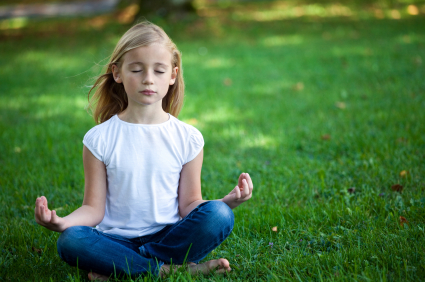
Introducing meditation to children and youth
If you are just introducing your child to meditation, try to keep your sessions short; in fact, the younger the child, the shorter the initial sessions should be. Children who have been meditating for some time can tolerate longer sessions, but a general rule of thumb as you are starting out is to strive for one minute per year of age.
It is also crucial to minimize distractions and establish a particular place as the mediation space—one intentionally free of toys, video games, and television programs. Having designated pillows or cushions for you to sit on can also establish this time and place as “meditation time” as well as provide comfort while sitting. This last point is important, since it is difficult enough to eliminate stray thoughts from your mind without the distraction of an uncomfortable body.
You can start by helping your child concentrate on their breathing, focusing upon each breath as it is inhaled and then released. Encourage them to try making their inhalations the same length as their exhalations. Remind them that it will be difficult to keep their mind focused on their breath and, from time to time, their mind may wander. Sometimes, it’s helpful to simply acknowledge, “That’s a thought,” and go back to concentrating on breathing once again.
If your child needs more of a focus point than just breathing, invite them to think about breathing in “peace” and breathing out “love.” They can say these words aloud as they breathe, or simply hold them in their mind as they meditate. You may also turn on some meditative music or tune in to the soothing sound of a water fountain.
Teenagers are generally more capable of keeping their physical bodies still. However, they are less likely to be skillful at keeping their minds quieted, particularly if they are new to meditation. In fact, our youth are much more skilled at filling up their minds—with music, texting, TV and computer games. Today’s adolescents are highly skilled at multitasking, but meditation requires the opposite of multitasking, which may seem foreign and uncomfortable for many youth at first. However, given time and repeated efforts, the benefits of meditation for quieting the overactive minds of our youth cannot be overstated.
When teaching meditation to adolescents, many of the same guidelines apply: eliminate possible distractions, establish sacred space, and keep the sessions relatively short at first. It is also important to work with your youth to establish a time and place that works for him or her. Since teens may have the additional challenge of turning off that inner critic which is ever present, practicing meditation in their own time and space is critical.
Finally, because children often mimic what they experience, if you do engage in meditation yourself, set aside some times when they can witness your practice. While it may not be as effective for you to meditate while your child is around, it can be helpful to remember that modeling is one of the easiest ways for children to develop skills. So have your private meditation time, but also create opportunities for them to see you meditate and think of ways you can communicate the benefits you gain from the practice.
Photograph above ©2009 Katja Bone/iStockphoto







